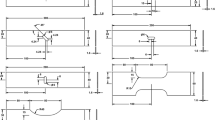Abstract
The alternating current field measurement technique has been employed in the present study to predict cracks of different profiles. Profiles used included surface thumb-nail cracks of semi-circular, semi-elliptical, asymmetrical and rectangular shape with aspect ratios ranging from 2 to 10. From the potential ratios measured experimentally, a numerical approach was employed to compute the crack profiles. Crack profiles were also computed from theoretical potential profiles obtained using boundary element method. The present study shows that with high aspect ratios, the crack profiles predicted using theoretical data bore great resemblance to that of the actual. The underpredictions at the centre-line position of the cracks were small. Using experimentally measured potentials with 1-dimensional interpretation, all predicted profiles showed an under estimation of the actual. The errors appeared generally lower for the narrower plate and decreased with increase in aspect ratio. Pseudo-random errors were introduced to the theoretical potentials to simulate measurement errors that may occur in practice, to improve the error handling capability of the computer programme designed for the study. In addition, a smoothing technique was also applied to improve the accuracy of the crack profile prediction. By “freezing” some of the distant potential field, a significant computer processing time reduction of 25–35% has been achieved.
Similar content being viewed by others
References
D. E. Pettit and W. E. Krupp, Proceedings of a Symposium at the 1972 Western Metal and Tool Exposition and Conference, Los Angeles (1972), pp. 53–71.
M. Lugg,Met. Mater. 5(3):142–144 (1990).
K. H. Lee, M. O. Lai, and T. H. Tan, 8th International Conference on Boundary Element, Tokyo (1986), pp. 179–192.
M. P. Connolly, D. H. Michael, and R. Collins,J. Appl. Phys. 64:2638–2647 (1988).
W. D. Dover, F. D. W. Charlesworth, K. A. Taylor, R. Collins, and D. H. Michael,The Measurement of Crack Length and Shape During Fracture and Fatigue (Engineering Materials Advisory Service Ltd., Warley, UK., 1980), pp. 222–260.
W. D. Dover, F. D. W. Charlesworth, K. A. Taylor, R. Collins, and D. H. Michael, ASTM STP 722 (1981), pp. 401–427.
F. W. D. Charlesworth and W. D. Dover,Advances in Crack Length Measurement (Engineering Materials Advisory Service Ltd., Warley, UK., 1982), pp. 253–276.
D. H. Michael, R. T. Waechter, and R. Collins,Proc. Roy. Soc. Lond.A381 (1982).
Author information
Authors and Affiliations
Rights and permissions
About this article
Cite this article
Lai, M.O., Ng, C.K. Measurement of crack-profiles using AC field measurement method. J Nondestruct Eval 13, 155–163 (1994). https://doi.org/10.1007/BF00742581
Received:
Revised:
Issue Date:
DOI: https://doi.org/10.1007/BF00742581




